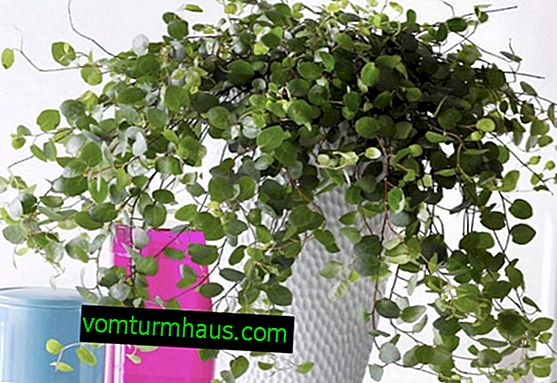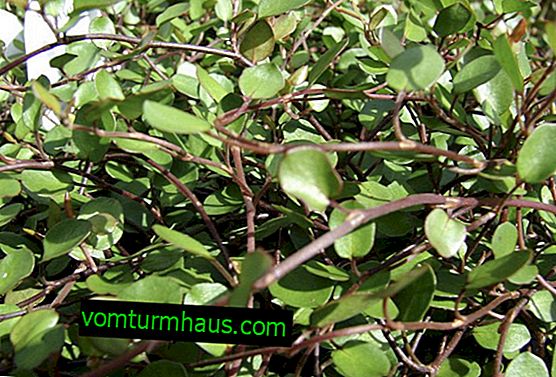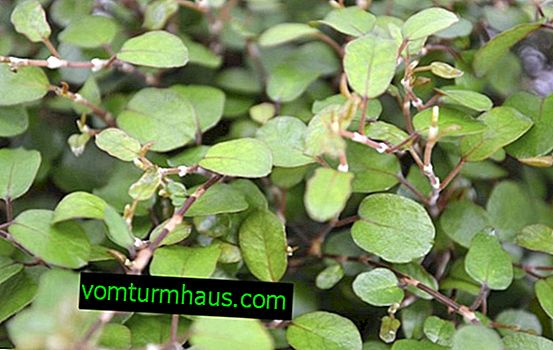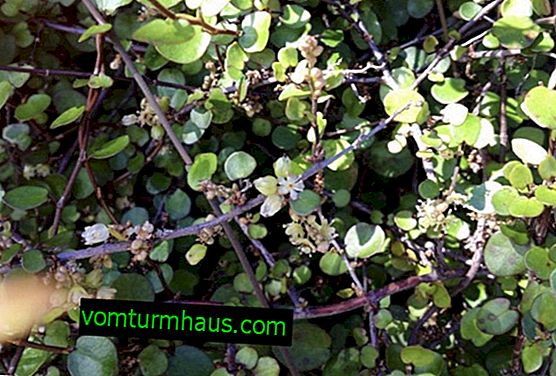Mühlenbeckia: home care
An elegant tropical vine with a dense crown and many small emerald-colored leaves - this is how Mühlenbeckia looks, a houseplant that many flower growers prefer to plant at home. Due to its graceful, confused, hanging shoots, the plant was called mulenbekia tangled or ampule mulenbekia. Looking at her, it seems that openwork and weightless clouds are comfortably located in flowerpots. How to grow this unusual plant at home will be discussed in our material.
Botanical description of the plant
This tropical culture belongs to the buckwheat family, is a deciduous shrub, in the genus of which there are 12 species. In the natural environment, liana grows in Australia, South America, New Guinea and Africa. For home breeding, only confused mulenbekia is used.

Important! Direct sunlight, like a thick shadow, is destructive for the mulenback: in the first case, delicate leaves and stems can dry out, and in the second, the shoots will stretch and thin out.
Culture blooms from early August in the form of rare axillary inflorescences, panicles, consisting of small white-green flowers that exude a persistent sweet aroma. After flowering, small, edible seeds with small seeds are tied to the plant.
| Root system | Fibrous |
| The stalks | Creeping, creeping, covered with smooth reddish bark |
| Leaf shape | Round, oval or lobed |
| Leaf color | Bright green |
| Flower shape | Axillary inflorescences in the form of panicles, consist of 1–5 five-petalled bells 5 mm in diameter |
| Flower color | Whitish green |
| Fruit shape | Spherical achene with many tiny seeds |
| The taste of fruit | Suitable for food |
The main types
If you decide to purchase this ampelous plant, you need to familiarize yourself with the existing decorative varieties in order to choose the most interesting for yourself.
There are some varieties of decorative mulenbek, differing in the shape of the leaves:
- Grandifolia (Grandifolia) - there are oval leaves of large size (2.5 cm).

- Covering (Сomplexa) - there are small rounded leaves 1.5 cm in length.

- Microphylla (Microphylla) - has rounded leaves of medium size.

- Nana (Nana) - has the smallest leaves densely located on the shoots.

- Maori (Maori) - oval leaves (2 cm) have a base and petioles are reddish.

- Tribalata cheeses (Tribolata Chees) - there are leaves with three pronounced lobes.

Conditions for successful growing at home
Despite its decorative appearance, openwork Mulenbekia is considered a shade-tolerant and unpretentious culture that does not require special growing conditions. But still she needs some systemic care.
Did you know? Ampelic plants are those that are grown in small hanging baskets and flowerpots . The word "ampel" comes from the Latin ampulla - a small hanging bottle or flask.
Location and Lighting
Preferred locations for the described tropical plant will be:
- light shadow;
- a northern window with sufficient diffused sunlight in the morning and evening (in summer);
- location at some distance from the south window;
- western and eastern sides (with shading);
- diffuse lighting;
- location in the center of the room or at height.

Temperature and humidity
The following requirements are imposed on temperature and humidity indicators:
- temperature regime of culture in summer - +20 ...– 25 ° C;
- in winter, flowerpots are transferred to a cool room (+10 ...– 14 ° C);
- Neighborhood mulenbeky with heating appliances is unacceptable;
- if the air temperature rises above +23 ° C, plants will need regular spraying;
- in winter, the culture is sprayed only with too dry air in the room (drying leaves with a faded color will indicate this).
Home Care
At home, the vines need to ensure optimal watering, timely feeding and pruning, as well as comply with the rules of transplantation.
Watering
In order for the liana to grow and develop normally, the soil in the flowerpot should be moderately moist. In the warm season, irrigate with settled, soft water 3 times a week. Water for irrigation should be warm, within + 20-24 ° C. The roots of the vines are very sensitive to excess moisture, so after moistening the soil in a flowerpot, excess fluid from the pan must be drained.

Top dressing
Fertilizing the crop is necessary from May to August.
To do this, adhere to the following principles:
- they feed mulenbekia once every 14–20 days;
- complex fertilizers used for indoor flowering crops are suitable for fertilizing;
- from autumn to mid-spring, feeding is stopped.
Learn more about how to feed indoor plants at home.
Pruning
The described plant tolerates pruning and bush formation well.

- Mulenbekia are well formed, so they can be cut, pinched, tied and trimmed as you wish, taking into account different types of cultivation (in a hanging basket, a flowerpot on a leg, with the installation of a support on which the stems are fixed, etc.);
- pruning is carried out exclusively with sharp tools, disinfected with alcohol or a weak solution of potassium permanganate (knife, scalpel);
- sections should be treated with sulfur powder or crushed burnt wood;
- elongated and bare stems are subjected to cardinal pruning to stumps (in early spring), so that the crown can recover;
- forming pruning is performed during the growing season;
- Excessively overgrown bushes are subjected to “sanitary” pruning: most of the shoots are removed from them (to stimulate thickening).

Transfer
The plant is transplanted once a year, in mid-April, in the following sequence:
- a larger volume is prepared (3 cm) than the previous one;
- the substrate is laid in the container: universal soil mixture or soil used for ornamental deciduous plants (with an acidity of 5.7–6 pH);
- you can prepare the substrate with your own hands, mixing peat, garden soil and river sand in equal parts;
- first, a drainage layer in the form of fine-grained expanded clay is laid on the bottom of the flowerpot, and then an earthen mixture;
- the soil under the transplanted bush is moistened to accurately extract the plants from the pot;
- the young bush is gently shaken out, holding at its base, and an older bush needs to be dug up with a spatula, keeping an earthen lump in both vines;
- the roots of the plant are carefully placed in a recess done in a fresh, slightly moistened soil, sprinkled with the rest of the soil mixture and rammed from above.

Breeding
Mulenbekia can reproduce in several ways:
- cuttings;
- layering;
- seeds.
Cuttings
Cuttings are the easiest way to propagate vines, which is carried out according to the following rules:
- In the spring or summer period, strong stems are selected, apical cuttings of 10–15 cm are cut off from them and placed in a container with water for root germination (Kornevin growth stimulant can be added to water for rooting cuttings).
- After the appearance of the roots (after about 2 weeks), seedlings are planted in pots with a light nutrient substrate of 5-6 pieces.

Layering
The procedure for the propagation of ampel liana by layering is carried out in 2 stages:
- Place another container with a soil mixture next to the pot with mühlenbeckia, deepen part of the shoot in the internodes into the adjacent pot without cutting it, and sprinkle with soil (it is necessary to fix the cuttings in the new pot so that it does not move).
- After 2 weeks, the rooted cuttings are separated from the main plant and transferred to a new pot or left to grow further at the site of recent rooting.

Seed cultivation
For seed cultivation of the described culture, planting material can be obtained in two ways:
- purchase in a specialized store or on the Internet;
- assemble yourself.
Did you know? In the Asian jungle, biologists discovered a giant vine called “elephant”, entangled in up to 50 crowns of various trees. This species of climbing plants has 3 meter pods - one of the longest in the world. To use the second method, the following steps will be required:
- Wait for the fruit to ripen after pollination of the achene (within 1 month), pick the achene, open and dry the seeds.
- In the spring, in a flat container with a light sand-peat mixture, sow seed material (seeds are scattered on the surface, lightly sprinkled with soil mixture) and cover with film material.
- Set the container in a warm place in bright light.
- When shoots appear in 1.5–2 weeks, the film must be removed (after sufficient seedling germination).
- Pickling seedlings to produce 5 pieces in separate pots (diameter 5 cm), while being careful. Dive them after the appearance of the fourth leaf on each seedling.
Growing difficulties
Mulenbekia is quite resistant to diseases and parasites, so it is easy to grow it in an apartment. But if we allow errors in the content of this plant, as a result, you may encounter some difficulties and problems in its cultivation.

- Spider mite. Appears due to the content of the culture in excessively hot conditions. Removing the affected leaves will help to solve the problem, followed by spraying and washing the entire vine with insecticides according to the instructions for each drug (“STOP tick”, “Fitoverm”, “Clean trunk”, “Koragen”, etc.).
- Root rot. It occurs due to waterlogging of the plant. There are several ways to deal with this problem: dry the earthen lump in the pot, transferring the vine to moderate humidity, transplant the flower into a fresh substrate, previously removing the roots damaged by rot, and dipping the living ones in 0.2% Fundazole solution (this must be done with caution, since mulenbekia does not tolerate manipulations with the root system).
- Partial fall of foliage in the spring and summer. It happens as a result of a drought or waterlogging of an earthen coma. This problem is solved by observing a moderate watering schedule.
- Drying and falling of leaves and shoots due to the presence of a vine under direct sunlight. You can fix the problem by placing a flowerpot with a vine in a diffused shadow and regular spraying it.
- Yellowing leaves. Caused by excessive air dryness in the room. A healthy color to the leaves will help to maintain maintaining a sufficient level of humidity in the room and spraying.
- Lack of flowering. It happens due to violation of wintering rules, watering norms or lack of lighting. The problem is solved by establishing the cause of the violation and its elimination.










